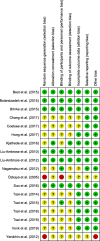Functional and/or structural brain changes in response to resistance exercises and resistance training lead to cognitive improvements - a systematic review
- PMID: 31333805
- PMCID: PMC6617693
- DOI: 10.1186/s11556-019-0217-2
Functional and/or structural brain changes in response to resistance exercises and resistance training lead to cognitive improvements - a systematic review
Abstract
Background: During the aging process, physical capabilities (e.g., muscular strength) and cognitive functions (e.g., memory) gradually decrease. Regarding cognitive functions, substantial functional (e.g., compensatory brain activity) and structural changes (e.g., shrinking of the hippocampus) in the brain cause this decline. Notably, growing evidence points towards a relationship between cognition and measures of muscular strength and muscle mass. Based on this emerging evidence, resistance exercises and/or resistance training, which contributes to the preservation and augmentation of muscular strength and muscle mass, may trigger beneficial neurobiological processes and could be crucial for healthy aging that includes preservation of the brain and cognition. Compared with the multitude of studies that have investigated the influence of endurance exercises and/or endurance training on cognitive performance and brain structure, considerably less work has focused on the effects of resistance exercises and/or resistance training. While the available evidence regarding resistance exercise-induced changes in cognitive functions is pooled, the underlying neurobiological processes, such as functional and structural brain changes, have yet to be summarized. Hence, the purpose of this systematic review is to provide an overview of resistance exercise-induced functional and/or structural brain changes that are related to cognitive functions.
Methods and results: A systematic literature search was conducted by two independent researchers across six electronic databases; 5957 records were returned, of which 18 were considered relevant and were analyzed.
Short conclusion: Based on our analyses, resistance exercises and resistance training evoked substantial functional brain changes, especially in the frontal lobe, which were accompanied by improvements in executive functions. Furthermore, resistance training led to lower white matter atrophy and smaller white matter lesion volumes. However, based on the relatively small number of studies available, the findings should be interpreted cautiously. Hence, future studies are required to investigate the underlying neurobiological mechanisms and to verify whether the positive findings can be confirmed and transferred to other needy cohorts, such as older adults with dementia, sarcopenia and/or dynapenia.
Keywords: Cognition; Neuroplasticity; Physical activity; Strength exercises; Strength training.
Conflict of interest statement
Competing interestsThe authors declare that they have no competing interests.
Figures



References
-
- Raz N. Regional brain changes in aging healthy adults: general trends, individual differences and modifiers. Cereb Cortex. 2005;15:1676–1689. - PubMed
-
- Raz N, Rodrigue KM, Head D, Kennedy KM, Acker JD. Differential aging of the medial temporal lobe: a study of a five-year change. Neurology. 2004;62:433–438. - PubMed
-
- Raz N, Gunning FM, Head D, Dupuis JH, McQuain J, Briggs SD, et al. Selective aging of the human cerebral cortex observed in vivo: differential vulnerability of the prefrontal gray matter. Cereb Cortex. 1997;7:268–282. - PubMed
LinkOut - more resources
Full Text Sources
Medical

